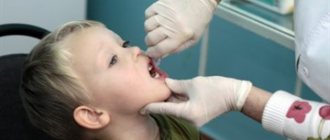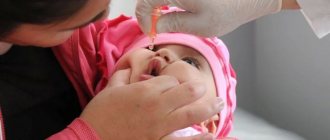DPT – vaccination against whooping cough, diphtheria and tetanus. Providing comprehensive protection against the above diseases, it is administered in parallel with the administration of the polio vaccine/administration of an immunobiological drug orally. According to the NKPP, this type of immunization is included in the list of mandatory ones. Reason: diseases the development of which is prevented by vaccination are accompanied by severe consequences and have a high risk of death. So, in particular, before the introduction of vaccination, the mortality rate from tetanus was 90%, from diphtheria - 25%.
What are the dangers of whooping cough, diphtheria, tetanus and polio?
Whooping cough belongs to the category of highly contagious infectious diseases.
It is severe, lasts up to 10 weeks or more, and is characterized by bouts of painful coughing that even medications do not relieve. The susceptibility of unvaccinated children to the causative agent of this disease is 100%. In advanced cases, whooping cough leads to the development of pneumonia, encephalopathy, and seizures. Children under 1 year of age (untreated) may suffocate. After three to four unsuccessful attempts to cough, they stop breathing. Diphtheria is characterized by a delayed manifestation of consequences. For example, toxic myocarditis can develop at 2–3 weeks of illness. Neuritis and polyradiculoneuropathy – 1–3 months after complete recovery. If a person has not been vaccinated against diphtheria, it can threaten his life. The cause of possible mortality can be paralysis of the respiratory muscles, infectious-toxic shock, or multiple organ failure.
Tetanus is considered one of the most “persistent” bacterial diseases. Its causative agent can withstand heating up to 80° for 1 hour, and the spores can remain viable for up to 100 years (if the habitat is soil). Pulmonary embolism, myocardial infarction, fractures of the bones of the upper and lower extremities, vertebrae, and other complications of tetanus develop during the height of the disease. The outcome of the disease is determined by the severity of its course, including death.
Poliomyelitis in its severe form leads to paralysis. By affecting the tissues of the cervical, thoracic and lumbar spinal cord, it promotes innervation of the muscles of the lower extremities. In the upper extremities, the normal functioning of the triceps, deltoid muscles and forearm supinators is blocked. Complications of this disease include pneumonia and myocarditis. With the bulbar form of polio, there is a possibility of encountering acute dilatation of the stomach, the formation of ulcers, and intestinal obstruction.
Contraindications and possible complications
The most serious consequence is infection of children with compromised immunity who received protection from a vaccine with an inactive but viable pathogen. Since the immune system of infants is still imperfect, specific immune protection is achieved through the use of IPV.
Attention! It is prohibited to carry out initial series of vaccinations with OPV drops!
The following are considered contraindications for IPV:
- Acute infectious pathologies;
- chronic infections during exacerbations;
- individual allergic reaction.
Notes The manipulation should be carried out 1 – 2 months after the child’s recovery. If you have an allergy, consultation with a pediatric allergist is indicated.
OPV is contraindicated in the following situations:
- if there is a history of neurological pathology;
- neurological complications were observed during the first vaccination;
- the presence of tumors and immunodeficiencies;
- if the baby has manifestations of an acute infectious disease.
Important! To avoid negative consequences, only healthy children are allowed to be vaccinated after a thorough examination by a doctor and examination.
OPV has virtually no complications, sometimes low-grade fever and allergies occur, and rarely diarrhea, which does not require treatment.
The injectable IPV drug is usually well tolerated, mostly causing a minor local reaction, but other consequences are possible:
- soreness and hyperemia at the injection site;
- swelling of adjacent tissues;
- low-grade fever;
- lethargy and drowsiness;
- irritability;
- rarely - a general reaction of the body with seizures or anaphylaxis.
More than thirty years have passed since, thanks to immunization, polio ceased to be endemicly dangerous in the Russian Federation. When preparing their child for such a procedure, parents should study the pros and cons of vaccines. Of course, clinics use domestic drugs free of charge. Their foreign analogues may in some ways be superior to them in terms of cleaning quality and cause less negative effects. You must pay for their introduction. Which means to choose is up to you.
Vaccination schedule
According to the NKPP, the course of prevention of the development of diphtheria, whooping cough and tetanus involves three-time vaccination.
Thus, the patient is vaccinated at 3, 4.5 and 6 months. At 1.5 years of age, primary revaccination is performed. When the child reaches 6 years of age, the immunization procedure is repeated. At 14 years of age, the third revaccination is performed. Afterwards, patients are vaccinated every 10 years from the date of the last vaccination. Important: since the timing of DTP administration coincides with the time of another important preventive measure - preventing the development of polio, both directions are combined.
DTP vaccination is not always carried out according to plan. Sometimes the immunization schedule changes. In some cases, the pediatrician develops an individual patient vaccination plan. There are many reasons why the prevention schedule may shift.
These include:
- weakness of the body, passing through the acute stage of the disease during the vaccination period;
- insufficient weight (the child was born premature) for immunization;
- the patient’s absence from the territory of the Russian Federation for a period from 3 months to 1 year with the inability to be vaccinated with a domestically produced vaccine.
You should know: the DPT vaccine is only allowed up to 4 years of age. If the child did not have time to be vaccinated during this time period, the immunization procedure is carried out with ADS-toxoid (at 4–6 years old) or ADS-M-toxoid (for older patients). The latter provide protection to the body only from diphtheria and tetanus. There is no pertussis component in their composition. As for the prevention of polio, it is carried out separately.
Possible side effects
In rare cases, in the first few hours after taking BiVac Polio, an immediate allergic reaction may develop. After administration of the vaccine, usually from 5 to 13 days, the following reactions may appear: vomiting, fever, headache. Allergic reactions (Quincke's edema, urticaria) occur very rarely. It is extremely rare, in absolutely isolated cases, that vaccine-associated paralytic poliomyelitis occurs.
Come get vaccinated at MAMARADA. A full range of vaccines for children and adults, family vaccinations - at a special price!
How to prepare for DTP administration?
In order to minimize side effects, it is necessary to adhere to certain rules. In particular, a young patient should not have contact with potential carriers of the virus, both before and after vaccination. Before getting vaccinated, the optimal solution would be for one parent to stay in the hospital to “hold the line,” and the other to go for a walk with the child. Afterwards, you should avoid crowded places for several days.
Before being vaccinated against whooping cough, diphtheria and tetanus, and polio, the child needs to be examined by a pediatrician. Only a specialist will be able to give an independent assessment of the young patient’s condition and, having excluded all possible contraindications, give him permission to administer the immunobiological drug. Important: before vaccination, the child must be healthy. The slightest manifestations of colds and other diseases are grounds for issuing a temporary medical exemption from vaccination.
Contraindications for vaccination
Permission to vaccinate a child/adult with DTP is issued in each case individually.
A patient may be temporarily prevented from undergoing immunoprophylaxis if he/she has:
- exacerbation of a chronic disease;
- acute stage of an infectious disease;
- weakened immunity after surgery, etc.
However, some restrictions fall into the category of false contraindications. Those. The vaccine can be given, but only after the patient’s condition has normalized. These are prematurity, diathesis, seasonal allergic diseases, severe adverse reactions to DTP and convulsions in relatives. There is also a list of absolute contraindications to vaccination against whooping cough, diphtheria, tetanus, and polio.
It includes:
- sensitivity to vaccine components;
- primary and secondary immunodeficiency conditions;
- progressive diseases of the nervous system;
- severe adverse reactions to the previous administration of the drug.
Such patients are vaccinated with ADS, a vaccine that does not contain a pertussis component. At the same time, it is mandatory for them to consult a specialist, take tests, and undergo additional medical examination.
Vaccine injection site
The associated vaccine (includes pathogens: whooping cough, diphtheria, tetanus, polio) is administered intramuscularly.
For children 0–3 years old, the injection site is the anterolateral thigh. For adult patients – deltoid muscle. Injection of the drug into the gluteal region is prohibited. Reason: low effectiveness of vaccination, high risk of damage to blood vessels and the sciatic nerve. In cases where polio prevention involves the administration of a separate vaccine, the method of performing this medical procedure is determined by the stage of vaccination and the manufacturer's recommendations. So, in particular, the IPV vaccine (inactivated polio vaccine) is given in the shoulder, subscapular region or thigh. Live OPV vaccine is administered orally. In the latter case, it ends up on the lymphoid tissue of the pharynx or palatine tonsils. The child is asked to throw back his head and open his mouth, where 2 or 4 drops are dripped (determined by the dosage of the drug).
What to do after vaccination?
You must remain on the premises of the medical facility for half an hour after vaccination.
Reason: if an acute reaction to the drug occurs, doctors will be able to quickly come to the rescue. The risk of complications will be reduced to almost zero. At the same time, it is not necessary to sit next to the vaccination room. You can go outside and take a walk near the clinic (and within reach of the medical staff, and good for your health). When you get home, the child should be given an antipyretic. Afterwards, throughout the rest of the day you need to monitor changes in his body temperature. Experts believe that hyperthermia is not one of those reactions that contribute to the development of a persistent immune response. If the child does not complain about his health, you can go for a walk with him. At the same time, it is extremely undesirable to visit people, play on playgrounds, or visit crowded places.
You can take a shower with water at room temperature. It is not advisable to take a steam bath or wash in a hot bath for 2–3 days after vaccination. The vaccinated body is weakened and vulnerable to diseases. The best solution during this period of time is to completely avoid overheating and cooling. It will be optimal if the air temperature in the room does not exceed 22°C and the humidity is 70%.
Overfeeding a child is not recommended. This will negatively affect his condition. Drinks can be given without restriction. In this case, as a liquid to quench your thirst, you should not use juices, but warm water, weak tea, or chamomile infusion. As for nutrition, it is recommended to temporarily remove allergenic foods from it (chocolate, red berries, mushrooms, hard cheese, etc.). Also, new foods should not be introduced into the diet to avoid the occurrence of a specific immune response.
The body's reactions to DTP
After administration of an immunobiological drug, the patient may experience minor changes at the injection site. Belonging to the category of local reactions, they are expressed in:
- redness;
- the appearance of compaction;
- swelling
The child may complain of leg pain and have a slight limp. As a rule, such unpleasant symptoms disappear within a week. If they do not disappear, consultation with a specialist is required. For reference: most often hypermia and pastosity (edema) are caused by vaccines that contain adjuvants to enhance the immune response. Along with local ones, the child may exhibit general reactions to the vaccine.
These include:
- increase in body temperature;
- stool disorder;
- increased nervous excitability;
- appetite disorders.
The child may complain of headache, weakness, and insomnia. All this is normal. However, one should be able to separate natural reactions to DTP from pathological conditions. The latter are prolonged crying, fever, difficulty breathing, convulsions, and temporary immobility. To facilitate the child’s rehabilitation period after vaccination, it is recommended to strictly follow the doctor’s recommendations. In particular, give him an antipyretic to prevent an increase in body temperature. Remember: malaise (in its moderate manifestations) is a normal reaction. It speaks of the launch of processes in the body for the development of specific immunity.
Possible complications
Severe reactions to DTP can occur if the young patient has not been examined correctly.
There were contraindications, but despite this the vaccination was done. These consequences of vaccination include:
- disturbances in the functioning of the central nervous system;
- severe allergic reactions;
- residual convulsive states.
Immunization with OPV can cause the development of vaccine-associated poliomyelitis. Statistics show that the latter occurs in 1 case per 1,000,000 and most often has an abortive form (without paralysis). Severe disease is extremely rare. Having a paralytic form, it is expressed in damage to different parts of the nervous system: spinal, pontine or bulbar.
Indications for vaccination "BiVac Polio"
"BiVac Polio" is indicated for revaccination (second stage of immunization) of children against polio after the first two vaccinations with inactivated polio vaccine.
Epidemic and social indications for BiVac Polio vaccination:
- Children over 3 months of age who have been in contact with a patient - a single dose.
- Doctors, paramedical and junior medical personnel who work in conditions of high risk of infection - once.
- Workers in clinical and virology laboratories who are in contact with a live wild strain pathogen receive a single vaccination during employment.
- Children over 3 years of age and adults who travel to countries with an unfavorable polio situation - once.
- For persons without a fixed place of residence - once if they have previous vaccinations, three times if they have not.
Types of vaccines
Based on their ability to develop immunity to one or more pathogens, all vaccines are divided into mono- and associated. The former provide protection against one disease. The second - from several (example: whooping cough, tetanus, diphtheria). In particular, polio prevention can be carried out either in parallel with DTP vaccination or be included in the complex immunization program with one drug. It all depends on the manufacturer.
BiVac Polio (Russia)
Monovaccine intended for the prevention of polio.
It includes the pathogen virus (attenuated Sabin strains type 1, type 3), magnesium chloride, kanamycin - no more than 30 µg per 1 dose of the drug. Statistics indicate that the presented drug has a high degree of seroconversion. Thus, in particular, stable immunity to the disease is developed in 90–95% of patients who have successfully completed the vaccination procedure. BiVac Polio can be used in conjunction with DTP (vaccination of the patient with ADS or ADS-M toxoid). The possibility of using the drug with other vaccines included in the list of approved NKPP is allowed. Each case is considered individually. It should be remembered that immunosuppressants can reduce the immune response to OPV vaccination. They can also cause the virus to multiply and increase the time it is excreted in feces.
Immunization with BiVac Polio can be carried out from 6 months. Before this, polio prevention involves the use of IPV (inactivated vaccine with destroyed virus particles). Vaccination with such a drug is permissible only for healthy patients. It is strictly prohibited to use it as part of the prevention of polio in pregnant women, patients with neurological disorders and immunodeficiency conditions, and children at risk.
ADS (Russia)
A two-component vaccine used to prevent diphtheria and tetanus.
It contains toxoids of the above-mentioned diseases, as well as auxiliary substances. Characterized by the absence of a pertussis component, ADS is considered a weakly reactogenic drug. In some vaccinated people, it can cause general and local reactions. In exceptional cases, it can cause an exacerbation of an allergic disease. ADS is allowed to be administered in parallel with the administration of other NKPP vaccinations. The main thing is not to mix it in the same syringe with other drugs for parenteral administration. Taking immunoglobulin does not affect the prevention of diseases with such a vaccine. It is also possible to carry out immunization with the parallel use of maintenance doses of steroids.
The DTP vaccination can be given from 3 months of age (if there are contraindications to DPT and developed immunity to the whooping cough virus). If a young patient has not been vaccinated against diphtheria and tetanus, the option of vaccinating him with this drug up to 6 years is allowed. Afterwards, prevention of the above diseases is carried out using ADS-M toxoid. Temporary reasons for medical withdrawal from such vaccination include diseases of infectious and non-infectious etiology, chronic diseases in the acute stage. It is strictly forbidden to administer the ADS vaccine in case of severe adverse reactions or post-vaccination complications caused by the patient’s primary immunization.
DTP (Russia)
A three-component vaccine aimed at combating whooping cough, diphtheria and tetanus.
It contains the causative agents of the above diseases, as well as aluminum hydroxide, thiomersal - no more than 57.5 µg per dose of the drug. A vaccination course with this drug consists of three vaccinations. Upon completion, the vaccinated person develops a stable specific immunity (subject to compliance with the schedule approved by the NKPP). DPT can be administered in parallel with the polio vaccine. It is also allowed to be used in conjunction with the prevention of other NKPP diseases. An exception is BCG (prevention of tuberculosis). If a young patient has not received a vaccination using this drug before the age of 4 years, it is not given. As an alternative, children under 6 years of age are immunized with ADS-toxoid, and older adults with ADS-M-toxoid.
The minimum age for primary DTP vaccination is 3 months. Revaccination is performed when the patient is 4.5 months old. Next - in six months. Contraindications to the use of such a drug include diseases of the nervous system in the progression stage, a history of afebrile convulsions. Its use is not allowed in case of sensitivity to the components of the immunobiological drug, accompanied by severe reactions (hypermia over 3 cm in diameter, fever up to 39°C).
Pentaxim (France)
Associated vaccine to protect the body from whooping cough, diphtheria, tetanus, polio, hemophilus influenzae infection. It contains the causative agents of all the above diseases and auxiliary substances. According to statistics, this type of drug shows high seroconversion rates. So, in particular, antibodies to diphtheria and tetanus are observed in 100%, to polio – in 99%, to whooping cough and hemophilus influenzae infection – in 88% of the vaccinated population.
The possibility of joint use of Pentaxim with other immunobiological drugs does not have reliable data. The only thing it suggests is that it should not be allowed to be mixed with other NCPP vaccines. You should know: within 1–2 weeks after receiving such a vaccination, a urine test may give a positive reaction to the Haemophilus influenzae virus. Taking this into account, other methods of diagnosing the disease in question should be used.
Vaccination with Pentaxim can be carried out from 2 months. Further, vaccination with such a drug will be given according to an individually approved immunization schedule: 2-3-4, 2-4-6 or 3-4-5 (according to the recommendations of the attending physician). The vaccine should be used with caution in patients with brachial neuritis and Guillain-Barré syndrome. Its use for immunization of children with progressive encephalopathy or intolerance to the components of the drug is prohibited.
Imported or domestic: which vaccine is better to vaccinate against polio?
According to the approved plan, the child is first given two doses of vaccinations containing killed viruses, and the remaining four injections are given with drugs in which the pathogen is alive but weakened.
Among domestic products, one-component BiVac Polio is used.
Many parents prefer to vaccinate their children with imported vaccines, this is explained by the presence of a number of advantages in such drugs:
- higher quality;
- do not cause vaccine-associated polio;
- minimal likelihood of developing adverse reactions.
All vaccines are effective and well tolerated.
Reviews about vaccinations
- Valeria, 24 years old.
This is my first child, very dear and desired. He was born healthy and is growing to the delight of my husband and I and our grandparents. We were very worried. I was afraid of the consequences - I read a lot about allergies, swelling and everything else. The doctor spoke about a possible rise in temperature. And so it happened: in the evening I developed a low-grade fever, and my son was a little naughty. However, the next morning all the symptoms disappeared. Subsequently, the injection was reminded of the injection for some time by a slight redness around the injection site, which disappeared without a trace after a week.
- Miroslava, 35 years old.
I have two children: a boy of six years old and a girl, still quite a baby: she is already six months old. Son Anton is growing up as a strong and healthy boy; all vaccinations were done according to schedule. I don't remember having any reaction to the polio vaccine. From the injection, I remember the temperature rose slightly, which my son did not even notice. The baby is already past two vaccinations, which we bravely endured, screaming a little. In the evening the temperature rose to 37.4, but it went away without treatment. At six months we were already given drops. I didn't notice anything bad at all.
- Oksana, 30 years old.
My son was born premature. Despite this, he began to gain weight normally, and by the time of the first vaccination he had almost caught up with his peers. The doctor said that vaccination is simply necessary, this technique will protect the baby from a terrible disease. Moreover, there are currently no contraindications. They convinced me that the Imovax vaccine is purified and has minimal side effects.
Everyone was very worried. But, surprisingly, my son suffered from the polio virus very easily and without consequences. Except that in the evening he was a little capricious. The morning after the vaccination we saw a “prick” reaction.








